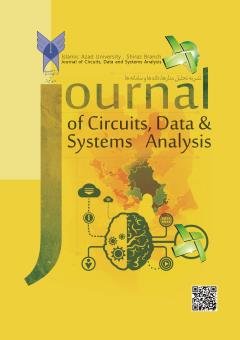Direct Power Control in Doubly-fed Wind Turbine Induction Generators using Fuzzy Controller
Subject Areas : Power Engineering and Energy Management
1 - Department of Electrical Engineering, Fasa Branch, Islamic Azad University, Fasa, Iran
Keywords: Wind Energy Conversion Systems, Variable Speed Wind Turbines, Doubly-Fed Induction Generators, Maximum Power Point Tracking,
Abstract :
Wind is a convenient and powerful source of energy. Power generation in a variable speed wind turbine is an interesting topic; since in wind energy converter systems, maximum utilization can be achieved at any speed. But this system needs its parameters to calculate the optimal speed of the turbine. In this article, a control method for tracking the maximum power point in the wind energy converter system is presented, which has been used for simulation and design along with fuzzy control by Mamdani method. In this article, the wind energy converter system is a two-fed induction generator, which is connected to the grid with a rotor and a stator. The input of the control system is the difference between the desired speed of the generator and its actual speed. The optimal speed is the rotational speed at which the generator receives the maximum power from the wind turbine. After conducting simulations and designing a suitable fuzzy controller for the system, it was found that the incorrect selection of a parameter has an adverse effect on the control process of a system.
[1] Liang J . Yongxing Qiu .(2015). “The modeling and numerical simulations of wind turbine generation system with free vortex method and Simulink”, Energy Conversion and Management 103 pp: 762–777,2015.
[2] Sukanta Roga and etl. , Recent Technology and Challenges of Wind Energy Generation: A Review, Sustainable Energy Technologies and Assessments, No.52, pp:1-17, May 2022.
[3] Mohammadjavad Mobarra and etl., Variable Speed Diesel Generators: Performance and Characteristic Comparison, Failure Diagnosis and Prognosis of Induction Machines, Energies , 15(2), 592,2022.
[4] Tapia A, Tapia G, Ostolaza JX, etl .(2003). Modeling and control of a wind turbine driven doubly fed induction generator. IEEE Trans Energy Convers 2003;18(2):194–204.
[5] Petersson A, Thiringer T, Harnefors L, et al . Modeling and experimental verification of grid interaction of a DFIG wind turbine. IEEE Trans Energy Convers,20(4):878–886,2005.
[6] Batoul Amen Alsati and etl., Study the impact of transient state on the doubly fed induction generator for various wind speeds, Journal of Engineering and Applied Science, NO.65, Jun 2023.
[7] Akel F, Ghennam T, Berkouk EM, etl ., An improved sensorless decoupled power control scheme of grid connected variable speed wind turbine generator. Energy Convers Manage ,No78,pp:584–594,2014.
[8] Koa HS, Yoonb GG, Kyunga NH, etl ., Modeling and control of DFIG-based variable-speed wind-turbine. Electr Power Syst Res,No78,2008.
[9] Bekka H, Taraft S, Rekioua D, Bacha S ., Power control of a wind generator connected to the grid in front of strong winds. J Electr Syst,9(3),pp:267–278,2013.
[10] Bianchi, F.D., De Battista, H., Mantz, R.J .(2010). Robust multivariable gain- scheduled control of wind turbines for variable power production. Int. J. Syst. Control 1 (3), 103–112.
[11] Mateescu, R., Pintea, A., Stefanoiu, D ., Discrete-time LQG control with disturbance rejection for variable speed wind turbines. In: 1st International conference on Systems and Computer Science—ICSCS 2012, Lille, France, August, pp. 1–6,2012.
[12] Nourdine, S., Camblong, H., Vechiu, I., Tapia, G ., Comparison of wind turbine LQG controllers designed to alleviate fatigue loads. In: 18th Mediterranean Conference on Control and Automation—MED 2010, Marrakech, Morocco, June, pp: 1591–1596,2010.
[13] Maria Letizia Corradini and etl., A control strategy for variable-speed variable-pitch wind turbines within the regions of partial- and full-load operation without wind speed feedback, Asian Journal of control, Vol.25, Issue5, Sep 2023.
[14] Ramadge, P., Wonham, W.M ., Supervisory control of a class of discrete event processes. In: Bensoussan, A., Lions, J.L. (Eds.), Lecture Notes in Control and Information Sciences, vol. 63. Springer-Verlag, Heidelberg, pp. 475–498, 1987.
[15] S. Morimoto. H. Nakayama. M. Sanada. and Y. Takeda .(2005). "Sensorless Output Maximization Control for Variable-Speed Wind Generation System Using IPMSG," IEEE Trans. on IndustlY Applications, vol. 41, no. I, pp.60-67, Jan/Feb. 2005.
[16] T. Senjyu, N. Nakasone, A. Yona, S. A. Yousuf, T. Funabashi, and H. Sekine ., "Operation Strategies for Stability of Gearless Wind Power Generation Systems," Proceedings of IEEEIPES General Meeting 2008 (GM 2008), CD-ROM, pp: 1-24, July 2008.
[17] Md. E. Haque, M. Negnevitsky, and K. M. Muttaqi .(2010). "A Novel Control Strategy for a Variable-Speed Wind Turbine With a Permanent-Magnet Synchronous Generator," IEEE Trans. on Industry Applications, vol. 46, no. 1,2010.
[18] W. Qiao, L. Qu, and R. G. Harley ., "Control of IPM Synchronous Generator for Maximum Wind Power Generation Considering Magnetic Saturation," IEEE Trans. On Industry Applications, vol. 45, no. 3, pp. 1095-1105, May/June 2009.
[19] S. M. Muyeen, R. Takahashi, T. Murata, and J. Tamura .(2009). "Integration of an Energy Capacitor System With a Variable-Speed Wind Generator," IEEE 7)·ans. on Energy Conversion, vol. 24, no. 3, 2009.
[20] G. Lalor, A. Mullane, and M.O .,’Malley, “Frequency control and wind turbine technologies,” IEEE Trans. Power System, vol. 20, no. 4, pp. 1905–1913, Nov. 2005.
[21] Tina Samavat and etl., A Comparative Analysis of the Mamdani and Sugeno Fuzzy Inference Systems for MPPT of an Islanded PV System, international journal of energy research,vol.2023, Apr 2023.


